All About Black, Gray and Clear Sea Glass
Get to know Sea Glass’s most mysterious palette…
 When you think about sea glass, visions of glowing soft aqua, seafoam and greens… scattered with a few blushing pinks and soft lavender purples may spring to mind. These tropical sunrise colors are sea glass classics, but the sea also shapes subtle tones from clear through every shade of gray, to almost pure black.
When you think about sea glass, visions of glowing soft aqua, seafoam and greens… scattered with a few blushing pinks and soft lavender purples may spring to mind. These tropical sunrise colors are sea glass classics, but the sea also shapes subtle tones from clear through every shade of gray, to almost pure black.
These colors are sometimes overlooked by the newbie sea glass hunter because they love to blend into the beach stones they are often found between. But, in
the sparkling sunlight, clear sea glass glows with the colors surrounding it – reflecting the blue of sky and sea. Light gray reveals its inner-glow to the sun as well, but those almost blacks… they often remain hidden.
But once discovered, they become some of the favorites of any collection. Grays from pure ash to almost a yellow, blacks with their hidden glow of green or amber, and clears from ice pink, to ice yellow to ice aqua, or truly colorless, each one is unique, and has a fascinating story to tell.
All About Black Sea Glass
 So, let’s talk black glass! For millennia, additives have been blended with sand, lime and soda, to give glass a color. Long about the 1500s, cleaver adult beverage distillers and brewers discovered that dark glass protected their glorious beverages from souring. The dark glass prevented the sun’s UV rays from souring the rum, beer and other goodies inside.
So, let’s talk black glass! For millennia, additives have been blended with sand, lime and soda, to give glass a color. Long about the 1500s, cleaver adult beverage distillers and brewers discovered that dark glass protected their glorious beverages from souring. The dark glass prevented the sun’s UV rays from souring the rum, beer and other goodies inside.
Hence, when you see Captain Jack dancing around the camp fire with a rum bottle, it is dark. These “black” bottles, whether onion-shaped like Jack’s, or mallet shaped like the one here (this bottle sank on the British East India Company vessel Queen in 1800, and spent 200 years under water) became the standard for 300 years. But if you hold these antique bottles to the light, it is rare to find one that is truly black. Almost every one of them shines either green or amber.
But if you hold these antique bottles to the light, it is rare to find one that is truly black. Almost every one of them shines either green or amber.
When you add chromium and iron to glass you are rewarded with a vibrant green, and if you add enough of these minerals, you’ll get a dark tone that takes on a deep, forest hue. Adding sulfur with iron produces a similar effect, although the underlying color will be amber.
To further darken the glass and increase its durability, it was common to add iron slag to the silica during the glassmaking. Sea glass that is found from these products is heavier, denser and sturdier than other more delicate types of glass. Now all the bottles I’m describing here are antiques – produced pre-1800, and most bottles of this type were made in Europe. It is there that you find the majority of old black sea glass. However… I love the Caribbean! And, it is there that almost of my black glass was discovered. Just like in the movies, the Caribbean was a trade center for the world throughout the 1600 – 1800s, and these glass bottles, filled with their prized liquids, were ubiquitous.
Now all the bottles I’m describing here are antiques – produced pre-1800, and most bottles of this type were made in Europe. It is there that you find the majority of old black sea glass. However… I love the Caribbean! And, it is there that almost of my black glass was discovered. Just like in the movies, the Caribbean was a trade center for the world throughout the 1600 – 1800s, and these glass bottles, filled with their prized liquids, were ubiquitous. Because the bottles were heavy, thick hand-blown vessels, you can still find quite large pieces of sea glass if you’re lucky and know where to look. While they are fast disappearing, if you are up for snorkeling or diving, and know exactly what you’re looking for, they can still be found.
Because the bottles were heavy, thick hand-blown vessels, you can still find quite large pieces of sea glass if you’re lucky and know where to look. While they are fast disappearing, if you are up for snorkeling or diving, and know exactly what you’re looking for, they can still be found.
If you’re lucky enough to find a piece of black sea glass, hold it up to the light to view how the true color shines through. It might be a dark olive or amber or even deep blue, red or purple. Whatever color it really is, black sea glass is quite extraordinary and one of the most prized of all sea glass colors.
Black Sea Glass – Five Fascinating Facts
 1. Black glass bottles were known as “junk bottles” by early glassmakers, perhaps because of the iron slag and carbon ash added to the glass mix to darken the olive green glass.
1. Black glass bottles were known as “junk bottles” by early glassmakers, perhaps because of the iron slag and carbon ash added to the glass mix to darken the olive green glass.
2. When you discover an antique black bottle, it often “leans” like it’s drunk – these bottles were free blown quickly so they are just a bit tipsy!
3. Black sea glass is almost always quite thick – the antique black bottles were made to be sturdy and durable.
4. There were very few black bottles produced in the 20thcentury, so black sea glass is almost guaranteed to pre-date 1900.
5. Black sea glass is usually deeply pitted – from the bubbles and imperfections in the original glass.
Black Sea Glass Jewelry
 While black is technically not a color, it is widely embraced as the color of elegance, mystery and power. At home with any color of the rainbow, black heightens the vibrancy of the colors that surround it.
While black is technically not a color, it is widely embraced as the color of elegance, mystery and power. At home with any color of the rainbow, black heightens the vibrancy of the colors that surround it.
Black is said to create a protective shield around the wearer and increase the ability to communicate with clarity and confidence.
Reach for your black sea glass jewelry when you’re looking for a boost in strength, authority and sophistication. With its air of glamour, black can be quite seductive and mysterious.
All About Gray Sea Glass
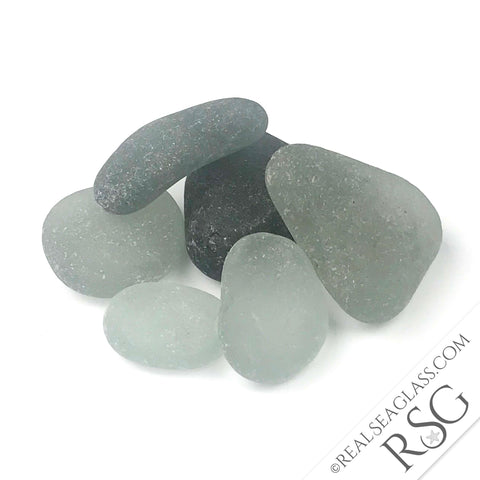 The history of gray glass is tied to directly to its two cousins “black” glass and clear glass. For thousands of years, glassmakers have been trying to achieve the perfection of truly colorless glass. While for us, clear glass is as ubiquitous as plastic, colorless glass centuries ago was the stuff of legend… but more on that below!
The history of gray glass is tied to directly to its two cousins “black” glass and clear glass. For thousands of years, glassmakers have been trying to achieve the perfection of truly colorless glass. While for us, clear glass is as ubiquitous as plastic, colorless glass centuries ago was the stuff of legend… but more on that below! Grey glass is very rare, and gets its color, not from the purposeful addition of mineral additive, but from the very nature of the sand used to make it. You see, sand isn’t pure silica… if it were, glass would be perfectly colorless. No, unfortunately for glassmakers throughout time (and fortunately for us sea glass fanatics) those pesky mineral pollutants in sand – most notably iron – create color in the finished glass, and in the old days, removing these impurities was impossible.
Grey glass is very rare, and gets its color, not from the purposeful addition of mineral additive, but from the very nature of the sand used to make it. You see, sand isn’t pure silica… if it were, glass would be perfectly colorless. No, unfortunately for glassmakers throughout time (and fortunately for us sea glass fanatics) those pesky mineral pollutants in sand – most notably iron – create color in the finished glass, and in the old days, removing these impurities was impossible.
So, the soft dove gray sea glass we adore was once an “undesirable” gray bottle or piece of leaded glass tableware of times past. While manganese was added to glass to neutralize the greens and blues caused by iron in the sand, if, unknown to the glassmaker, copper was also present in the sand, the glass would develop a distinct gray shade over time! And, if that color crazy wasn’t enough to make early glassmakers tear their hair out, if the manganese, copper and iron in greying glass was exposed to lots of sunlight, that same gray glass could develop a green-gray or blue-gray hue! Of course, when we find shards with these lovely beachy tints, it makes our day – I guess times do change!
And, if that color crazy wasn’t enough to make early glassmakers tear their hair out, if the manganese, copper and iron in greying glass was exposed to lots of sunlight, that same gray glass could develop a green-gray or blue-gray hue! Of course, when we find shards with these lovely beachy tints, it makes our day – I guess times do change!
While some thinner grey glass may come from contemporary items like tinted automobile glass and television screens, most grey glass is thick and chunky, like the original heavy hand-blown bottles or leaded tableware it was.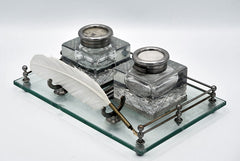 Gray glass ranges from the light hints of mist to the deepening shadows of a dark slate. You may even mistake it for a clear piece of sea glass until you get it home and place it next to your clear nuggets. You might also think that your black sea glass looks dark gray because of the way that the salt water and sand frost the surface. If you wet it or rub it with oil, it will reveal its true colors!
Gray glass ranges from the light hints of mist to the deepening shadows of a dark slate. You may even mistake it for a clear piece of sea glass until you get it home and place it next to your clear nuggets. You might also think that your black sea glass looks dark gray because of the way that the salt water and sand frost the surface. If you wet it or rub it with oil, it will reveal its true colors!
Gray Sea Glass – Five Fascinating Facts
 1. In the 1700s, English glassmakers produced a colorless glass with ground quartz rock – which is calcified flint – the called the glass… wait for it… FLINT.
1. In the 1700s, English glassmakers produced a colorless glass with ground quartz rock – which is calcified flint – the called the glass… wait for it… FLINT.
2. Thick, grey sea glass is almost always over 100-years-old!
3. The human eye can distinguish about 500 shades of gray.
4. Most gray glass, hence gray sea glass comes from the decade between 1915 – 1925.
5. Smoke gray carnival glass was made during the depression and given as prizes at fun fairs and carnivals – the dark gray glass was coated with a metallic spray to give it an iridescent effect.
Gray Sea Glass Jewelry
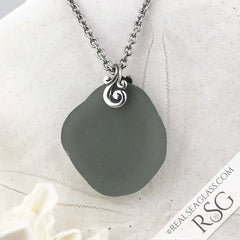 Grey is the quintessential color of intellect, knowledge and wisdom. Revered for its perfect balance between the extremes of black and white, gray is timeless.
Grey is the quintessential color of intellect, knowledge and wisdom. Revered for its perfect balance between the extremes of black and white, gray is timeless.
Grey is said to boost authority, endurance and clarity. It is refined, sleek and classic, and is at home paired with any color.
Wear your grey sea glass jewelry on that day you want the most in focus, attention to detail, stick-to-it dedication and calm assurance. Gray brings out balance in all areas – giving you the power you need with the calm to enjoy it.
All About Clear Sea Glass
 So, for my all my friends who are dedicated and super-passionate bottle collectors I have to have this disclaimer: clear glass is more properly called colorless glass, as clear glass is glass you can see through, as opposed to opaque, or milk glass, which you can’t see through… hence “clear green glass” or “clear blue glass.” However, for decades, the sea glass community has used the term “clear sea glass” to indicate colorless sea glass, so let’s go with that!
So, for my all my friends who are dedicated and super-passionate bottle collectors I have to have this disclaimer: clear glass is more properly called colorless glass, as clear glass is glass you can see through, as opposed to opaque, or milk glass, which you can’t see through… hence “clear green glass” or “clear blue glass.” However, for decades, the sea glass community has used the term “clear sea glass” to indicate colorless sea glass, so let’s go with that! Now, let’s deal with “white sea glass.” Some people use the terms “clear” and “white” interchangeably to describe sea glass. A piece of clear glass can look white when it develops its frosty patina. However, true white sea glass comes from milk glass, which is opaque. Clear sea glass is translucent under the frosting. So, I’ll just stick with clear for clarity’s sake (see what I did there?)
Now, let’s deal with “white sea glass.” Some people use the terms “clear” and “white” interchangeably to describe sea glass. A piece of clear glass can look white when it develops its frosty patina. However, true white sea glass comes from milk glass, which is opaque. Clear sea glass is translucent under the frosting. So, I’ll just stick with clear for clarity’s sake (see what I did there?)
While we’re used to seeing clear glass every time we open the pantry or refrigerator… our pre-1800s ancestors would have been amazed by the clear glass that is scattered throughout our homes.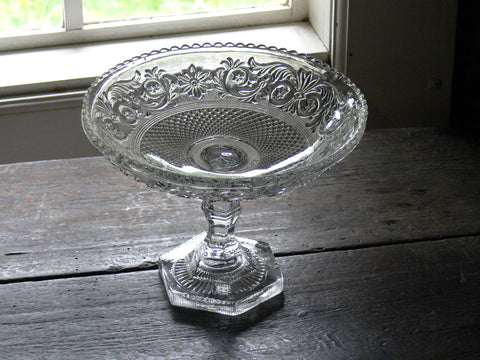 Why? Those pesky iron bits that naturally occur with the sand used to make glass! We look at the aqua-hued ancient Roman glass vessels to the hand-blown bottles of the 19thcentury and think “wow, that’s a wonderful ancient or vintage piece of glass with that gorgeous green-blue color!” while the artisans who made the glass were thinking “wow, I really wish I could get this darn stuff to be clear!”
Why? Those pesky iron bits that naturally occur with the sand used to make glass! We look at the aqua-hued ancient Roman glass vessels to the hand-blown bottles of the 19thcentury and think “wow, that’s a wonderful ancient or vintage piece of glass with that gorgeous green-blue color!” while the artisans who made the glass were thinking “wow, I really wish I could get this darn stuff to be clear!”
Little did early glassmakers realize that the small amounts of iron in their glassmaking sand were causing the glass to turn that soft blue green as it was blown. It wasn’t until the 1400s that Venetian glassmakers discovered that adding just a bit of manganese to the mix acted as a clarifier, neutralizing the effect of the iron and giving them what they craved… colorless glass. Well, it was colorless unless there were other impurities in the glass, or unless the glass were exposed to the UV rays of the sun. Then, manganese turned the glass a lavender hue, and if copper, lead or other elements were also present you would eventually get grey, green, blue or straw yellow colors.
Well, it was colorless unless there were other impurities in the glass, or unless the glass were exposed to the UV rays of the sun. Then, manganese turned the glass a lavender hue, and if copper, lead or other elements were also present you would eventually get grey, green, blue or straw yellow colors.
And this is why a true colorless piece of sea glass is usually from a bottle, plate or other piece created in the 20thcentury… by the early 1900s glassmakers moved to other decolorizing agents, and improvements in production led to less “pesky bits” of colorizing minerals in the glass. But, as anyone who collects sea glass knows, your mason jar or candy dish of clear sea glass has what I call “ice” colors – ice pink, ice purple, ice aqua, ice yellow… you get the idea. There are always those hints of color scattered among the frost colorless shards. These senior citizens of the clear sea glass world are just as lovely as their colorless companions, and they are often much thicker, as antique hand-blown vessels were heavier, thick walled fellows.
But, as anyone who collects sea glass knows, your mason jar or candy dish of clear sea glass has what I call “ice” colors – ice pink, ice purple, ice aqua, ice yellow… you get the idea. There are always those hints of color scattered among the frost colorless shards. These senior citizens of the clear sea glass world are just as lovely as their colorless companions, and they are often much thicker, as antique hand-blown vessels were heavier, thick walled fellows.
Whether truly colorless, or with just a hint of color, pieces of clear sea glass display the frosting and pitting of their journey to you beautifully. Softly rounded, their inner light highlights the sea etching on their wave worn surface.
Clear Sea Glass – Five Fascinating Facts
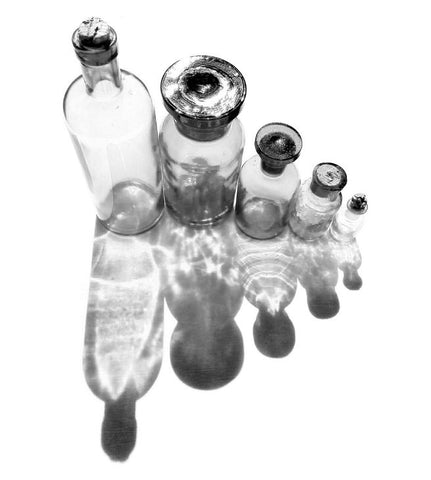 1. Archeologist, like sea glass hunters, use the subtle ice tints of clear glass fragments to date the glass… and, in the case of the archeologist, sometimes the entire site.
1. Archeologist, like sea glass hunters, use the subtle ice tints of clear glass fragments to date the glass… and, in the case of the archeologist, sometimes the entire site.
2. It was actually the glass blowers in Alexandrea who discovered how to create colorless glass about 100 AD, but the formula was lost until it was rediscovered by the Venetians in the 1400s.
3. Clear glass vessels were the height of luxury, elegance and sophistication in the 1500 – 1700s.
4. Sometimes a piece of clear sea glass is found that has wires running through it… it’s “safety glass.”
5. We sometimes discover sea glass with the remnants of the original embossing on it, or distinctive shapes – one the most identifiable is the round bottom of glass milk jugs once delivered by milkmen!
Clear Sea Glass Jewelry
 White, or clear, in this case, is actually the blending of all colors reflected back to the viewer. Hum, try and get your mind around that one. However, clear sea glass jewelry is valued for at the ultimate neutral – it’s white frosted glow goes with absolutely everything.
White, or clear, in this case, is actually the blending of all colors reflected back to the viewer. Hum, try and get your mind around that one. However, clear sea glass jewelry is valued for at the ultimate neutral – it’s white frosted glow goes with absolutely everything.
White is revered as the color of light, goodness, purity and perfection. Long used in heraldry to represent faith, white is simple, clean and fresh.
White is said to bring the wearer mental clarity, encouraging the purification of thoughts and actions. Clearing clutter and obstacles, white provides for fresh beginnings.
Your clear sea glass jewelry is perfect for the start of a new adventure in your life. If you’re looking to heighten your intuition, create something new, or simplify your life, this just might be your sea glass color of choice.
Valuing Black, Gray & Clear Sea Glass
 When you first started collecting sea glass you may have thought that sea glass is just sea glass. But you soon discovered that some colors are far rarer than others.
When you first started collecting sea glass you may have thought that sea glass is just sea glass. But you soon discovered that some colors are far rarer than others.
Just like one gemstones can vary greatly in value than another, the value of both gemstones and sea glass comes from its beauty as well as its rarity. Even if it is an more available color, the size and shape of your piece can also helps determine its value.
That being said, gray and black sea glass are quite rare. These colors most often come from vintage and antique glass that’s just not seen too much anymore. When found, they are often bulbous, thick and rounded, telling the story of their long-ago creation.
Clear sea glass ranges from the antique to glass just a few decades old. Most of the sea glass now discovered is some tint of white, however, among clear sea glass, there a varying values.
You see, glass usually breaks into triangular fragments. As it gets tumbled by sea waves and brushed against sand and rocks, it begins to smooth. Newer sea glass still retains its irregular edges, but glass that has ridden the waves for many more years looses its definition, become rounded and super-frosted. This clear sea glass is the most valuable among the clear color family. Likewise, finding a large piece of completely frosted sea glass is rare. Sizeable shards usually break as they hit rocky sea shores.
Likewise, finding a large piece of completely frosted sea glass is rare. Sizeable shards usually break as they hit rocky sea shores.
The rarer the sea glass, the more valuable it is. If you happen across black or gray sea glass that seems extremely cheap, please be on guard. This glass is almost always machine tumbled, and lacks the beauty, history and appeal of the real thing.
Whether you choose to hunt for your black, grey and clear sea glass here with us at RealSeaGlass.com, or on a beach near you, these lovely treasures have some of the most intriguing history of all sea glass colors!




